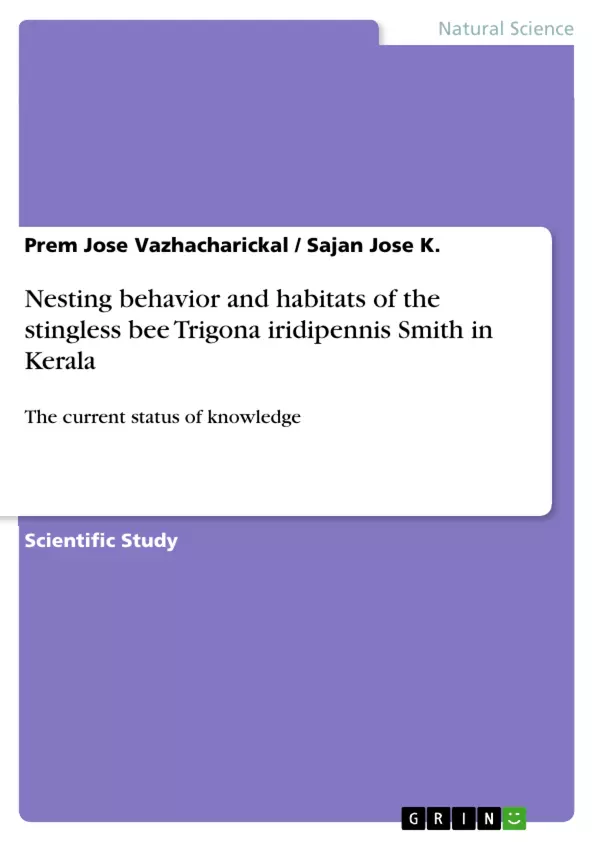Stingless bees are highly social insects which populated the tropical earth 65 million years ago and have been around much longer than honey bees. They are limited to the tropics and subtropics, lack a venom apparatus and cannot sting. Impacts of anthropogenic influences on honey bees have already been reported. Recent studies also showed that the nesting behaviour of Trigona iridipennis Smith in its natural habitat also varies due to interaction, pheromones and environmental stimulus.
Little is reported so far about the various natural and domesticated nesting of the Trigona iridipennis Smith in Kerala. Based on thise background, our objectives of this study were to 1) to characterize the Meliponiculture 2) to identify the various natural habitats and domestication materials for nest construction and different types of nests used across Kerala. Various beekeeping methods preferred by farmers across Kerala for the cultivation of Trigona iridipennis Smith. Each nest has its own advantage and disadvantage.
During the survey, the most preferred ones were wooden box. Even then according to the easy availability and production cost different nests like earthen pot, bamboo nodes, coconut shell, PVC pipes etc were used. The most preferred natural nesting sites by Trigona iridipennis Smith were mud/stone walls in our study. Being a social insect, Trigona iridipennis Smith shows great diversity in nesting pattern in natural habitats as well as anthropogenic habitats. The shift towards anthropogenic habitats than natural ones may be due to destruction of natural habitats as well as the availability of manmade habitats.
Inhaltsverzeichnis (Table of Contents)
- Abstract
- Introduction
- Hypothesis
- Materials and Methods
- Study area
- Study design and data collection
- Statistical analysis
- Results
- Nest architecture and characteristics
- Entrance tube
- Internal tunnel
- Resin dumb
- Waste Dump
- Food Storage
- Brood
- Pillars and Connectives
- Nest envelops
- Anthropogenic habitats
- Domesticated habitats
- Different types of nests
- Bamboo nodes
- Earthen pot
- Wooden Box
- Earthen bowl
- Coconut shell
- PVC pipe
- Nest architecture and characteristics
- Discussion
- Conclusions
- Acknowledgements
Zielsetzung und Themenschwerpunkte (Objectives and Key Themes)
This research focuses on characterizing Meliponiculture and investigating the nesting behavior of stingless bees (Trigona iridipennis Smith) in Kerala, India. The study aims to identify natural habitats and domestication materials used for nest construction, as well as analyze different types of nests utilized across the region. The research also explores the preferences of farmers in Kerala regarding various beekeeping methods for cultivating Trigona iridipennis Smith.
- Nesting behavior and habitat preferences of Trigona iridipennis Smith in Kerala.
- Comparison of natural and domesticated nesting sites for Trigona iridipennis Smith.
- Analysis of different types of nests used in Meliponiculture in Kerala.
- Exploration of the current status of Meliponiculture practices in Kerala.
- Examination of factors influencing the shift from natural to anthropogenic habitats for Trigona iridipennis Smith.
Zusammenfassung der Kapitel (Chapter Summaries)
The study begins with an introduction to stingless bees and their significance as pollinators and producers of valuable honey and propolis. It then presents the hypothesis guiding the research, which examines variations in nesting behavior and habitats of stingless bees in Kerala, as well as the different approaches employed by farmers in the region for beekeeping. The "Materials and Methods" section details the study area, data collection methods, and statistical analysis techniques used.
The "Results" section provides a detailed description of the nest architecture and characteristics of Trigona iridipennis Smith, including the entrance tube, internal tunnels, resin deposits, waste dumps, food storage, brood, pillars and connectives, and nest envelopes. The section then examines the natural and domesticated habitats utilized by the bees, analyzing the specific tree species and other materials employed for nesting.
The study further delves into different types of nests used in Meliponiculture, outlining the advantages and disadvantages of each method. The "Discussion" section analyzes the findings in the context of the ecological and anthropogenic factors influencing the nesting behavior of stingless bees. Finally, the "Conclusions" section summarizes the key findings and highlights the potential for further research into Meliponiculture and the demand for stingless bee honey in Kerala.
Schlüsselwörter (Keywords)
The research focuses on the nesting behavior and habitats of the stingless bee Trigona iridipennis Smith in Kerala. Key themes include Meliponiculture, anthropogenic habitats, entrance tube, and the importance of understanding the bee's adaptation to both natural and man-made environments. The research aims to contribute to the knowledge of beekeeping practices in Kerala and the potential of stingless bee honey.
- Citation du texte
- Prem Jose Vazhacharickal (Auteur), Sajan Jose K. (Auteur), 2016, Nesting behavior and habitats of the stingless bee Trigona iridipennis Smith in Kerala, Munich, GRIN Verlag, https://www.grin.com/document/347113



